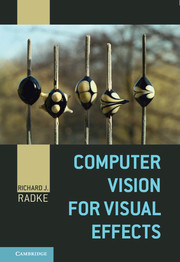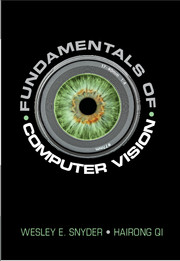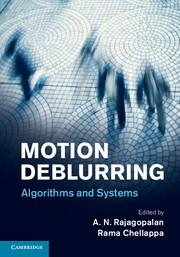Computer Vision for Visual Effects
$65.99 (C)
- Author: Richard J. Radke, Rensselaer Polytechnic Institute, New York
- Date Published: November 2012
- availability: In stock
- format: Hardback
- isbn: 9780521766876
$
65.99
(C)
Hardback
Other available formats:
eBook
Looking for an examination copy?
This title is not currently available for examination. However, if you are interested in the title for your course we can consider offering an examination copy. To register your interest please contact [email protected] providing details of the course you are teaching.
-
Modern blockbuster movies seamlessly introduce impossible characters and action into real-world settings using digital visual effects. These effects are made possible by research from the field of computer vision, the study of how to automatically understand images. Computer Vision for Visual Effects will educate students, engineers, and researchers about the fundamental computer vision principles and state-of-the-art algorithms used to create cutting-edge visual effects for movies and television. The author describes classical computer vision algorithms used on a regular basis in Hollywood (such as blue screen matting, structure from motion, optical flow, and feature tracking) and exciting recent developments that form the basis for future effects (such as natural image matting, multi-image compositing, image retargeting, and view synthesis). He also discusses the technologies behind motion capture and three-dimensional data acquisition. More than 200 original images demonstrating principles, algorithms, and results, along with in-depth interviews with Hollywood visual effects artists, tie the mathematical concepts to real-world filmmaking.
Read more- Includes film stills and interviews with Hollywood visual effects artists that tie the mathematical concepts to real-world film making
- Describes state-of-the-art algorithms
- Offers a general introduction to computer vision through the lens of visual effects; more than 150 exercises make the book suitable for use in the classroom as well as for professionals
Reviews & endorsements
"Hollywood's achievements in visual effects have been enabled not just by advances in computer graphics, but just as much by techniques from the neighboring field of computer vision. Vision techniques such as camera tracking, 3D reconstruction, and face and body motion capture contribute to most of the visual effects shots we see today. Rich Radke's book Computer Vision for Visual Effects begins with the basics and shows how math, geometry, image processing, and scene understanding comprise these tools that create the movies. Read it and you'll understand an important part of the magic that makes the films we love."
Paul Debevec, Scientific and Engineering Academy Award Winner for Lightstage WorkSee more reviews"Richard Radke has produced a computer vision textbook like no other. The field of computer vision is vast and varied and many techniques apply to only a small number of applications. This book does something completely novel: not only does it provide a clear, current, and detailed examination and explanation of the latest computer vision techniques, it also shows how these techniques are used in the practice of visual effects. Including interviews with visual effects practitioners, this book answers the question, ‘That's a cool technique, but is it useful?’ and it does it in a complete, well-written, and engaging way. Anyone thinking of applying computer vision techniques to visual effects problems (and more) should run to get a copy of this book."
Doug Roble, Digital Domain"The visual effects industry relies intimately on highly sophisticated computer vision algorithms and also provides one of the primary application areas for such algorithms. Richard Radke's comprehensive textbook on these subjects reviews hundreds of such algorithms with applications to topics such as image matting and compositing, feature tracking and matchmoving, motion capture, and 3D model acquisition. It will surely find a prominent place on both visual effect practitioners' and computer vision researchers' bookshelves."
Richard Szeliski, Microsoft ResearchCustomer reviews
Not yet reviewed
Be the first to review
Review was not posted due to profanity
×Product details
- Date Published: November 2012
- format: Hardback
- isbn: 9780521766876
- length: 405 pages
- dimensions: 261 x 180 x 26 mm
- weight: 0.97kg
- contains: 170 b/w illus. 50 colour illus. 2 tables 168 exercises
- availability: In stock
Table of Contents
1. Introduction
2. Image matting
3. Image compositing and editing
4. Features and matching
5. Dense correspondence and its applications
6. Matchmoving
7. Motion capture
8. Three-dimensional data acquisition
Appendix: optimization algorithms for computer vision.-
General Resources
Find resources associated with this title
Type Name Unlocked * Format Size Showing of
This title is supported by one or more locked resources. Access to locked resources is granted exclusively by Cambridge University Press to instructors whose faculty status has been verified. To gain access to locked resources, instructors should sign in to or register for a Cambridge user account.
Please use locked resources responsibly and exercise your professional discretion when choosing how you share these materials with your students. Other instructors may wish to use locked resources for assessment purposes and their usefulness is undermined when the source files (for example, solution manuals or test banks) are shared online or via social networks.
Supplementary resources are subject to copyright. Instructors are permitted to view, print or download these resources for use in their teaching, but may not change them or use them for commercial gain.
If you are having problems accessing these resources please contact [email protected].
Sorry, this resource is locked
Please register or sign in to request access. If you are having problems accessing these resources please email [email protected]
Register Sign in» Proceed
You are now leaving the Cambridge University Press website. Your eBook purchase and download will be completed by our partner www.ebooks.com. Please see the permission section of the www.ebooks.com catalogue page for details of the print & copy limits on our eBooks.
Continue ×Are you sure you want to delete your account?
This cannot be undone.
Thank you for your feedback which will help us improve our service.
If you requested a response, we will make sure to get back to you shortly.
×





